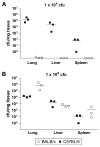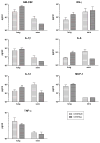Differential susceptibility of inbred mouse strains to Burkholderia thailandensis aerosol infection
- PMID: 19853031
- PMCID: PMC7006035
- DOI: 10.1016/j.micpath.2009.10.004
Differential susceptibility of inbred mouse strains to Burkholderia thailandensis aerosol infection
Abstract
Burkholderia pseudomallei is the causative agent of melioidosis, an emerging bacterial disease that accounts for high rates of septicaemia and death in parts of Southeast Asia and Northern Australia. The closely related species Burkholderia thailandensis is considered avirulent in humans and has been used as a surrogate for B. pseudomallei in several studies. The pathogenesis of B. pseudomallei and the role of Toll-like receptors (TLRs) in host immunity to infection are not well-defined. In this study, we exposed four strains of inbred mice (BALB/c, C57BL/6, TLR4-deficient C3H/HeJ, and TLR4-competent C3H/HeN) to increasing doses of aerosolized B. thailandensis to determine strain susceptibility and the role of TLR4 during pulmonary infection. Our results indicate an increased susceptibility in the C57BL/6 and BALB/c strains, who displayed lethality, bacterial burden in organs, and pulmonary and systemic inflammation. C3H/HeJ were as resistant as C3H/HeN mice to B. thailandensis at the highest challenge dose examined, but TLR4-deficient animals exhibited a modest increase in chronic pulmonary inflammation. These results demonstrate that B. thailandensis can be used as a surrogate for experimental laboratory investigation of melioidosis in small animal models and that TLR4 may not play a prominent role during acute pneumonic melioidosis.
Figures





References
-
- Wiersinga WJ, van der Poll T, White NJ, Day NP, Peacock SJ. Melioidosis: insights into the pathogenicity of Burkholderia pseudomallei. Nat Rev Microbiol. 2006;4(4):272–82. - PubMed
-
- Dance DA. Ecology of Burkholderia pseudomallei and the interactions between environmental Burkholderia spp. and human–animal hosts. Acta Trop. 2000;74(2–3):159–68. - PubMed
-
- Dance DA. Burkholderia pseudomallei infections. Clin Infect Dis. 2000;30(1):235–6. - PubMed
-
- Stone R. Infectious disease. Racing to defuse a bacterial time bomb. Science. 2007;317(5841):1022–4. - PubMed
Publication types
MeSH terms
Substances
Grants and funding
LinkOut - more resources
Full Text Sources
Other Literature Sources

